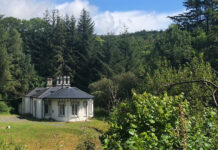
Sometimes, chimney issues get so bothersome that people want more than a simple cover; they demand that the chimney be sealed up, taken down, or both.
A draft, often described as a chimney leak or unwelcome chilly air from the hearth, is frequently the cause. Regardless of the driving force, many homeowners frequently come to this viewpoint. It is reasonable to assume that by the time people start thinking about chimney blockers, they have already tried other possibilities and are at their wits’ end with the problems their chimneys are causing.
Before we go into the specifics of blocking a chimney, you should be aware of the negative repercussions and the dos and don’ts of shutting off a chimney and fireplace.
Sealing a Chimney or Fireplace
A chimney essentially serves as an open doorway leading from the inside of the house to the outside. If a route is blocked off, it transforms into a containment, like a door or a window leading outside.
When a hearth is fired, creosote and soot build up inside the chimney walls, naturally releasing gases. What becomes of the gases and fumes if the chimney is closed or shut off? The fumes have nowhere else to go but back into the house if they can’t get up or out, which might be disastrous for anyone living there.
Half the chimney is open to the inside and half to the heat outside. The humidity in the entrapped air commonly condenses, turning into a liquid, on the inner surface of chimneys when the fireplace is blocked, and the chimney is sealed.
More moisture enters as the air keeps leaking in. A sealed chimney will let in more water than it used to before it was sealed up. This will result in problems with mould, odour, and water damage.
Dangers of Sealing a Chimney
Water continuously accumulates inside the flue after a chimney has been sealed up. It becomes a danger to the occupants of the house.
People may not realise that smoke and heat won’t depart the home if the chimney top is obstructed or sealed up, which might result in a hazardous situation. At the absolute least, all emissions and pollutants will enter the house again. The furniture of the house is damaged, and anyone inhaling the combustion fumes might become ill.
Sometimes there will be excessive heat accumulation within the fireplace and chimney. Without the ability to draft, chimneys will heat up to such extreme levels that they will melt glass doors, let flames inside the house, and scorch any nearby combustibles.
All these possible hazards from blocking a chimney can be cirumvented when you use the right blocking tools and get the professionals.
What to do before sealing the chimney if you use a Gas Fireplace
- Make sure to clean and remove all the dust before sealing off the chimney.
- Anyone with a rudimentary understanding of this subject may install a gas line; if you are unsure of your ability to do so, it is advised that you consult an expert installer.
- A covering must be built over the gas burner to prevent drainage problems.
- Your municipal or county government may levy fines if you violate the local construction codes.
- You should not attempt this setup until you are sure and possess all the required tools; any alterations might result in leaks and explosions that could harm you or others.
- Before the gas line enters the home, be careful to place a shut-off nozzle as close as you can to the line and on each side of that line.
Chimney sealing options
If you decide to seal your chimney, consider these options.
Chimney Cowl
A chimney cowl often resembles a hood and is placed over the chimney hole. A chimney cowl, which is often attached chimney pot top, serves to boost the chimney’s draft, reduce downdraft, keep the weather extremes out of the chimney, and keep birds and squirrels from building nests inside the chimney interior. Style, size, and purpose all vary among chimney cowls. From simple bird screens to more elaborate hangers that are intended to vastly enhance your chimney’s draft.
You would do well to get a chimney cowl because it protects your chimney from bad weather conditions, animal infestation, and downdraft.
The chimney cowl is the best blocking option for your chimney and can be easily purchased in Ireland.
Chimney Balloon
A balloon can also be used to seal off the chimney. You pump it and position it above the chimney opening to stop gases from escaping; you have to pop it to get it off. The beautiful thing about this solution is that it doesn’t require professional installation, but the types of logs that may be used are limited. Additionally, it may be challenging to install and remove, depending on the balloons you choose. It may be challenging to install and detach.
Chimney Cover Clamp
Identical to a cap in many ways, a cover for chimneys is made to fit across the entire opening instead of just on top. They are simple to install; however, if your chimney is attractive, they reduce the fireplace’s beauty.
Damper Clamp
Using these clamps is straightforward; all you have to do is set them out over vents. Once they are in place, even air will have difficulty passing through. They are ideal for quick installation and removal but bear in mind that unless you pick a clamp with a flap, there isn’t a way to stop gases from rising.
The Permanent Chimney Cover
If you want something a bit more permanent and would prefer something that integrates better with the appearance of your house, lasting chimney covers are a terrific option. These coverings include a screen covering the vent to keep fumes from leaking and connect to the hearth. If you decide to employ your gas lines, airflow is still an option to keep the air moving.
Metal Mesh Coverage
These coverings might work if you want a material that is even more durable than steel meshes. They are made to prevent any gases from escaping and are affixed directly to the fireplace. With them in place, you can continue to use your gas lines, but airflow will be closed off for the greatest possible protection from fumes.










